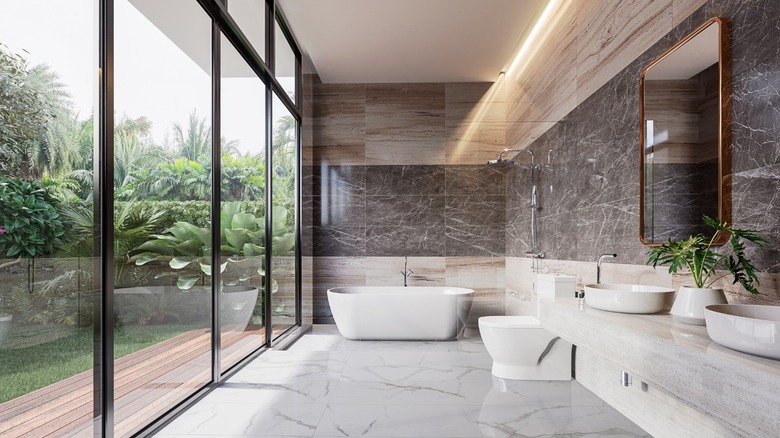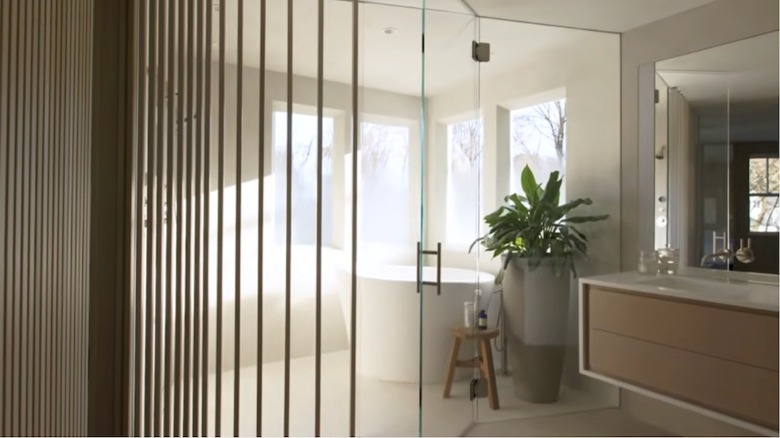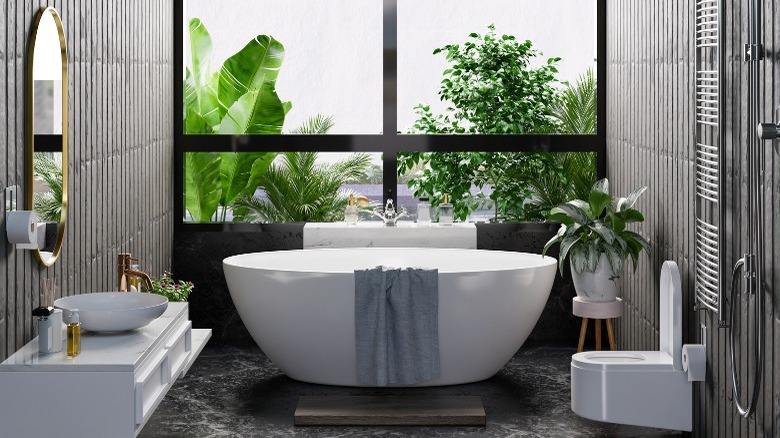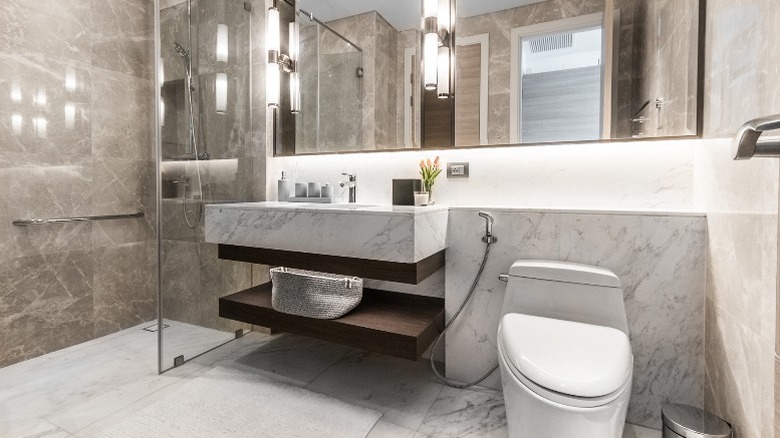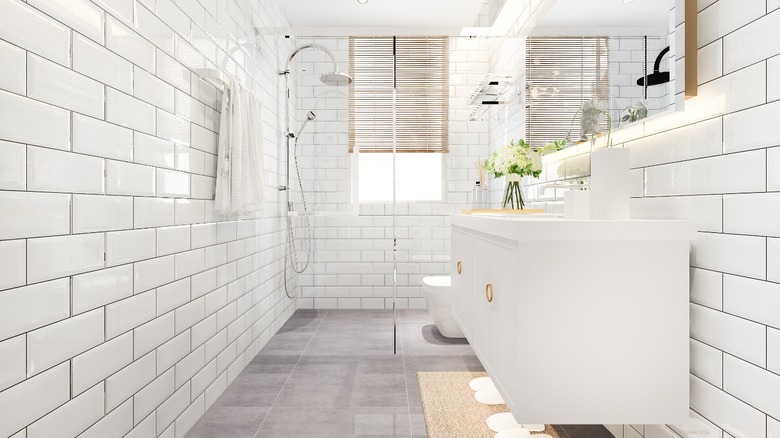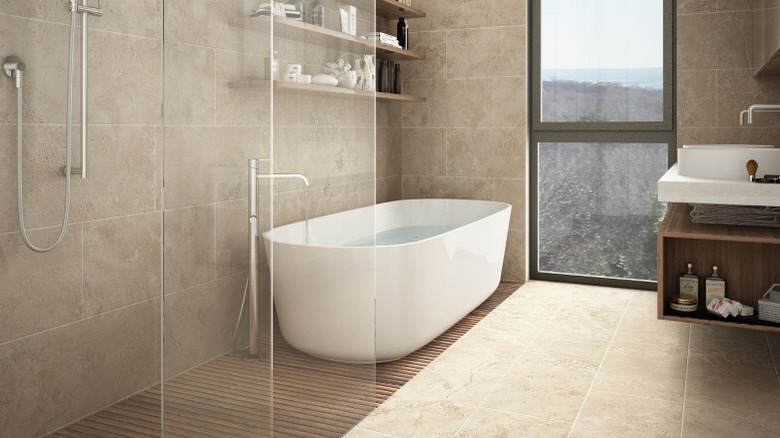5 Reasons Why You Should Consider Adding A Wet Room To Your Bathroom
Home trends come and go, and it's fun to change up our accent pillows or dinnerware every few years to reflect a new style or evolving tastes. However, more permanent changes can be cost-prohibitive, inconvenient, and even risky. Take bathroom renovations, for example. They can be expensive and disruptive, to say the least, and if not done appealingly, could turn away potential buyers during a sale. Yet Fortune Builders lists both minor and major bathroom renovation in its top five home improvements for a return on investment. In addition, upgrading a bathroom benefits daily routines and the look of the home.
Per HGTV, a developing bathroom remodeling trend, particularly in upscale properties, is a wet room. The outlet defines it as an area designed and constructed with materials that are resistant to water damage. They note that it can be a whole room or a division within the room, such as a tub and shower stall. Several factors are increasing the popularity of the feature, including efficient use of space and a minimal spa-like aesthetic. CCL Wetrooms shares that fewer fixtures and walls mean easier and faster cleaning. Lastly, a significant advantage of a wet room is its waterproof practicality. Below, we detail five reasons to consider the trend for creating a modern and timeless bathroom update.
Hotel style
According to CCL Wetrooms, the open layout and innovative design inherent in wet rooms contribute to a resort-like and luxurious atmosphere in the utilitarian space. The specialists point out that an uninterrupted floor plan allows a greater degree of choice regarding the size and placement of fixtures, which in addition to pragmatic considerations, can directly impact the aesthetics. Plank & Pillow praises a curbless shower for the way it creates a clean visual across the plane of the floor.
Plus, fewer partitions mean greater visibility of the fixtures and surface treatments. Designer Kristi Dinner described the benefits as such, "We're able to highlight a lot of sculptural tubs (with wet rooms) ... You can make the most of the materials," she continued (via HGTV). By the same token, the Big Bathroom Shop explains that open expanses create an opportunity for stunning tile, stone, and wood applications. Dinner emphasizes the need to employ professional architects and designers for a project of this magnitude to guarantee the most satisfactory appearance and function.
Efficient use of space
Per Bella Bathrooms, wet rooms are especially appropriate for space-challenged bathrooms; they can provide the same function as larger rooms within a smaller footprint. This can be achieved by way of combining the shower and tub into one enclosure, requiring fewer square feet than for separate placement, or by removing the tub altogether. Additionally, minimal or absent room dividers allow light flow and a fixture layout that makes optimal use of the floor plan. The bath fitter also explains that a supplemental quality of a bright and expansive environment is the illusion of more space. Furthermore, CCL Wetrooms indicates the design application is better able to work within architectural constraints, like a pitched ceiling for example; a shower-stall kit or other prefab components might not fit, causing the subsequent arrangement to make less-efficient use of the available space.
However, proper plumbing and fixture arrangement can be problematic in a teeny room. While Ideal Home notes that in a minute bathroom entirely occupied by a wet room, it may be difficult to keep items such as towels and toilet tissue dry, and it could be a poor place to store cosmetics or supplies. Realtor mentions the unpleasantness of a wet toilet or vanity counter and sums it up thusly: If the space is too cramped, a wet room isn't a practical option.
Increased accessibility
Wet rooms primarily have fewer enclosures as well as curbless and trayless showers, translating to a space that offers greater mobility than a conventional bathroom affords, per CCL Wetrooms. For the disabled, elderly, or anyone with limited mobility, the mostly level flooring (there will be a slight slope toward the drain), ample shower area, and increased space between fixtures add function, ease, and the opportunity for independence.
Sweeten notes that wet rooms can be designed in adherence to aging-in-place guidelines, providing assurance for older home buyers and renovators. The remodeling service explains that those same principles, with a focus on practicality, safety, and accessibility, are suitable for younger and growing families, too. For example, parents of small children may find bath time a bit less strenuous. CCL Wetrooms advises the use of non-slip tile while Friel Lumber Company recommends floor mats as an added safety feature.
Decreased potential for water damage
According to the Big Bathroom Shop, a wet room can be anywhere in the home provided the required waterproofing is undertaken correctly. Home Serve summarizes the process as first grading the floor to encourage water toward a drain away from the entrance, and next, tanking (waterproofing) the floor and lower part of the walls to protect underlying structural features. This is followed by priming and the application of a waterproof membrane, which can then receive vinyl, rubber, or tile. Non-slip ceramic and natural stone are popular tile choices for walls due to their attractive look.
CCL Wetrooms explains that the materials and methods implemented during the construction of a wet room provide a hardy and durable water-resistant surface that will endure through strenuous use, fairing better than a traditional bathroom. The material installation in cooperation with an updated plumbing system further ensures a space resistant to leaks. As an added benefit, powerful ventilation in the space helps to inhibit the formation of mold and mildew, per Friel Lumber Company.
Higher perceived value
Experts agree that a bathroom upgrade is a sound investment; Bella Bathrooms claims the average added value of 2.88% is even higher for a wet room renovation. Yet Realtor notes that the wet room trend is too new to track the associated financial rewards. And while they assert the feature is a signal of contemporary extravagance, sharing that some real estate agents perceive them to be an asset, they stress that the style of the space should complement the whole-home design. The modern aesthetic and impact of floor-to-ceiling tiled or wood walls affect a positive impression, including associations with quality, space, and luxury. CCL Wetrooms explains that the wow factor, updated plumbing, and perceived ease of cleaning make a home with a wet room more marketable. Further, the accessible layout and functionality will appeal to old and young buyers alike.
However, HGTV cautions that a wet room might not be universally attractive to future buyers. Some may not appreciate a shared tub and shower area, for example, and Friel Lumber points out that the hard and non-porous surfaces required in a wet room design are highly reflective of sound and light, adding up to a space that could feel cold, loud, and bright for some tastes.
